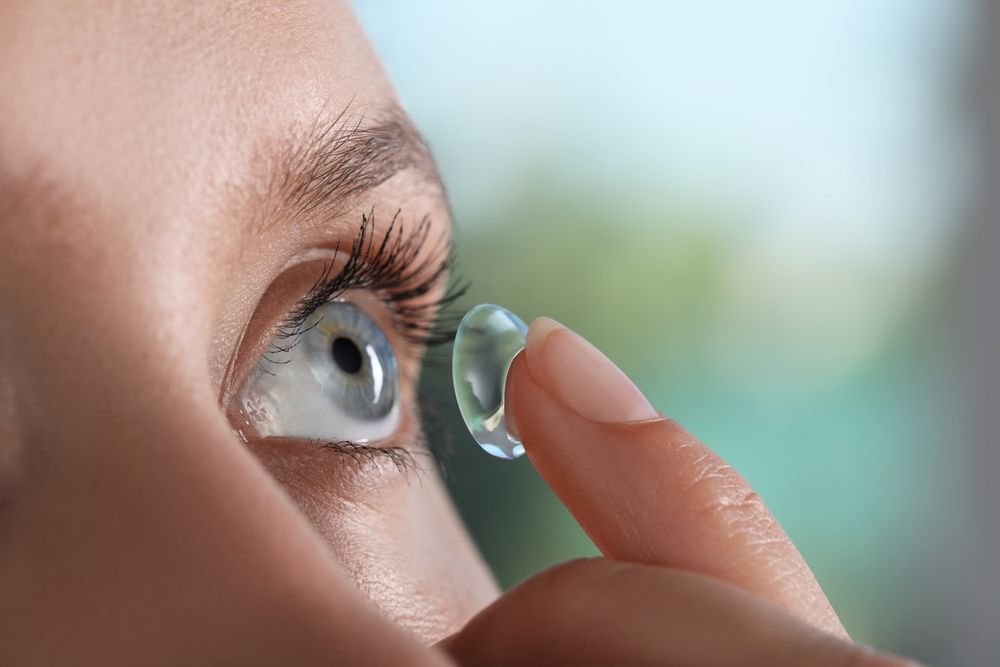Contact lenses have become a popular alternative to traditional eyeglasses, offering convenience and flexibility for those seeking vision correction. While contacts offer several benefits, they’re not without their challenges. This guide, brought to you by Dr. Abed Namavari at Colorado Eye Clinic in Greenwood Village, explores the pros and cons of contact lenses to help you determine if they’re the right choice for your lifestyle and vision needs.
Advantages of Contact Lenses
Contact lenses offer unique advantages over eyeglasses, particularly for those who lead active or fast-paced lifestyles. Here’s a look at the benefits that make contacts appealing.
1. A Natural Field of Vision
One of the primary benefits of contact lenses is that they provide a more natural field of vision compared to eyeglasses. Contacts rest directly on the eye’s surface, giving you a wider peripheral view without frames blocking your line of sight. This advantage is especially valuable for activities where peripheral vision is crucial, such as sports or driving.
2. Ideal for Active Lifestyles
Contacts stay in place during movement, making them an excellent choice for those with active lifestyles. Whether you’re running, playing sports, or working out, contacts won’t slip down your nose or fog up. This stability allows wearers to participate in physical activities without the inconvenience of readjusting glasses.
3. No Weather Interference
Contact lenses are not affected by weather conditions in the way that glasses are. With contacts, you won’t have to worry about rain, fogging, or glare on lenses affecting your vision. This convenience can be especially appealing in Greenwood Village and surrounding areas where weather can be unpredictable.
4. Cosmetic and Style Flexibility
For individuals who prefer a glasses-free look, contact lenses provide the option to see clearly without altering their appearance. Many people choose contacts for this reason, especially if they feel that glasses do not match their personal style. Contacts also offer a natural look, allowing your face to be seen without obstruction.
5. Option for Specialty Lenses
Contact lenses offer additional options for those with specific vision needs. Specialty lenses like multifocal contacts can address presbyopia, while toric lenses can correct astigmatism. Color-tinted lenses are also available for aesthetic purposes, allowing wearers to change their eye color temporarily.
Disadvantages of Contact Lenses
While contacts have many advantages, they are not the perfect solution for everyone. Here are some drawbacks to consider before making the switch to contact lenses.
1. Higher Maintenance Requirements
Contact lenses require daily cleaning and proper storage to ensure they remain safe to wear. This maintenance routine involves disinfecting solutions and careful handling to avoid contamination, which can be time-consuming. For those with busy schedules, this daily care routine may feel like an inconvenience compared to the simplicity of glasses.
2. Risk of Eye Irritation and Infections
Contacts are more likely to cause eye irritation and infections, especially if they are not handled properly. Bacteria can accumulate on lenses, particularly if they are not cleaned thoroughly. Symptoms of contact lens-related infections can include redness, itchiness, and even blurred vision. For some, these risks can outweigh the convenience of contacts, especially if they have a history of sensitive eyes.
3. Potential for Dry Eye Issues
Many people experience dry eyes when wearing contacts, especially in dry climates or during prolonged computer use. Contacts can restrict the natural flow of oxygen to the eyes, exacerbating dryness and discomfort for some wearers. Those with a history of dry eye may find contact lenses less comfortable, particularly in arid climates like those in parts of Colorado.
4. Learning Curve for Proper Application
Wearing contact lenses requires learning the correct way to insert and remove them. For some, this learning curve can be intimidating, particularly if they are not comfortable touching their eyes. However, with time and practice, most people become more confident in handling their lenses.
5. Higher Ongoing Costs
Compared to glasses, contacts can be more expensive in the long term. Regular purchases of lenses, cleaning solutions, and storage cases add up, creating ongoing costs that don’t apply to glasses. Additionally, individuals who opt for specialty lenses or daily disposables may find these costs increase further.
Who Should Consider Contact Lenses?
Contacts are a great choice for certain types of lifestyles and preferences, but they may not be suitable for everyone. Here’s a look at some factors to consider when deciding whether to try contacts.
Active Individuals
If you enjoy an active lifestyle, contact lenses can be a good fit. Their secure positioning on the eye and freedom from frames make them ideal for sports and exercise. Active individuals in Greenwood Village, Centennial, or Southglenn who value a seamless vision experience during their routines often benefit from contacts.
Frequent Outdoor Users
For those who spend significant time outdoors, contacts can offer clear and unobstructed vision. Unlike glasses, they don’t fog up or become affected by rain or humidity, making them a practical choice for various outdoor activities in Colorado’s diverse climates.
Style-Conscious Wearers
Contacts are popular with individuals who prefer a glasses-free appearance. They allow you to maintain your personal style without frames. With options for colored lenses, contacts also provide a way to experiment with eye color.
Alternatives to Contact Lenses
While contact lenses are a convenient option for many, other solutions may also work. Eyeglasses remain a versatile and effective choice for those who find contacts uncomfortable or inconvenient. Advanced materials and stylish designs make glasses a great accessory for everyday wear. Refractive surgeries like LASIK may be worth exploring for individuals seeking more permanent correction. Consulting with Dr. Namavari at Colorado Eye Clinic can clarify alternative vision correction options.
Making the Best Choice for Your Vision
Ultimately, the choice between contact lenses and glasses depends on your lifestyle, comfort, and vision needs. While contacts offer many benefits, they also come with maintenance requirements and potential drawbacks. By understanding the pros and cons, you’ll be better prepared to make an informed decision about whether contacts fit your lifestyle. For personalized guidance, consider scheduling a consultation at Colorado Eye Clinic, where Dr. Namavari can recommend the best solution for your unique vision needs in Greenwood Village.
Whether you’re exploring contacts for the first time or considering them as a replacement for glasses, understanding the full range of benefits and challenges can make a significant difference. With options to suit various activities, styles, and preferences, contact lenses may be just what you need for clear, flexible vision. If you’re still uncertain, visiting Colorado Eye Clinic can provide valuable insight and support in making the best choice for your eye health and lifestyle.
Sources:
- Brennan, N. A. (2005). Contact Lens Materials and Oxygen Transmission. Eye & Contact Lens Science and Clinical Practice.
- Efron, N., & Morgan, P. B. (2007). Rethinking Contact Lens Aftercare. Contact Lens & Anterior Eye.
- Nichols, J. J., & Sinnott, L. T. (2006). Tear Film, Contact Lens Comfort, and Dry Eye. Optometry and Vision Science.

